Asia-Pacific Region Serves as Template for Operational Challenges
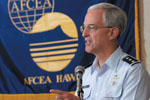 |
| Lt. Gen. Douglas M. Fraser, USAF, deputy commander of the U.S. Pacific Command, cites the need for greater understanding of networks in his keynote address at TechNet Asia-Pacific 2008. |
Now that network centricity is a given part of warfighting, it is undergoing growing pains that could hinder its greatest capabilities as the force embraces it fully. Service interoperability is as great a challenge as ever, and that task is complicated by the need to include both allies and nontraditional coalition partners in information networks.
The Global War on Terrorism is imposing new challenges as varied as the many cultures embroiled in that conflict, and that cultural diversity presents its own difficulties. Security in the age of cyberwar is becoming an even greater problem as network centricity extends down to the individual warfighter. And, as more advanced technologies move up on warfighters’ wish lists, they complicate efforts to reap the benefits of their promised capabilities.
All of these issues are prevalent in the Asia-Pacific region, and they were fodder for discussion at TechNet Asia-Pacific 2008, held in
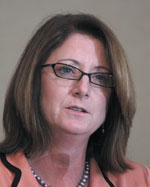 |
| Linda Newton, deputy chief of staff for command, control, communications, computers and intelligence (C4I), U.S. Pacific Fleet, describes how building a flexible and agile command and control structure will be a huge challenge. |
Within five years, wireless devices may give warfighters the upper hand in the Global War on Terrorism. Biometric personal digital assistants would share situational awareness, and weapons would be network-centric enabled. Supply inventories in mobile forces would be inventoried constantly and resupplied on time to a force’s exact location.
In 12 years, an individual network officer in a remote site on a faraway continent may receive an automatic network alarm that would allow that person to understand the network crisis immediately and remedy it from that site using a voice-operated system.
These scenarios will require several advances, including a seamless network—a requirement stated by nearly every panelist and speaker at TechNet Asia-Pacific 2008—along with proactive network security, advanced network management and a single common operational picture for all forces,
Networking will be the key, yet true jointness is elusive and the network itself can be a liability. Speaking at a panel,
“How do we take information at the data source that is not easily shareable … and share it?”
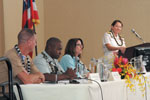 |
| Vice Adm. Nancy Brown, USN, J-6, the Joint Staff (r), listens to panelists discuss support to the warfighter (r-l): Linda Newton, deputy chief of staff for C4I, U.S. Pacific Fleet; Col. Bruce T. Crawford, USA, commander, 516th Signal Brigade; and Col. Scott Blankenship, USMC, G-6, U.S. Marine Corps Forces Pacific. |
Adm. Brown noted that the global network is a group of networks with seams, and the warfighter is left to overcome those seams. This forces the warfighter to be a systems integrator, which is not the goal of network centricity, she said.
For the next version of the Global Information Grid (GIG), known as GIG 2.0, she called for a new way of designing systems—putting the warfighter at the center instead of the Pentagon, which is at the center of current designs.
Col. Bruce T. Crawford,
The colonel warned about the departure of vital networking expertise as signal technologists move out of the workforce. “The bench in the Defense Department is severely lacking,” he stated.
That concern was echoed by the deputy commander of the U.S. Pacific Command. Lt. Gen. Douglas M. Fraser, USAF, said that the biggest challenge in securing and operating networks efficiently may be to understand them—which currently is not taking place. To illustrate his points, the general offered observations about network operations and security that tended to be more philosophical than technical.
People just don’t understand the network, and they must take a larger view of networks, he said. Users need an intuitive understanding of the network, and industry must assist by providing intuitive interfaces that help humans truly understand just what is happening in a network.
“Networks aren’t a thing to run. They are a place we need to understand,” he declared.
Security in particular requires a change in culture. Warning that nonkinetic attacks can have kinetic-like effects, Gen. Fraser called for a new approach to cyberspace security. Cyberthreats are growing, and just over the past year the Pacific Command lost thousands of human hours in capabilities and spend thousands of dollars to counter a network intrusion. Instead of security, the focus should be on assurance—in this case, risk management.
“Anyone who connects with the network must be a cyberwarrior,” he posited.
The
“One thing that worries me … we assume that our communications activity always will be there,” Gen. Fraser offered.
Those in charge of ensuring that communications always will be available have their own wish list, at the top of which is a new network that addresses current shortcomings and accommodates new capabilities. Little details such as network management, language, security and seams are major impediments to maintaining network centricity, say J-6s from the Asia-Pacific region.
“The net does not support my commander well,” said Col. Frederick W. Mooney, USAF, J-6, U.S. Forces Korea.
The problem facing U.S. Forces Korea is the seams between the various networks serving the command’s services, said Brig. Gen. Ronald Bouchard,
Gen. Bouchard said he also needs a scalable network common operational picture with a view from the strategic to the tactical. He wants to leverage technology such as digital sensors and security tools for network management and protection, and he wants better forensics. And, he wants to be able to share information across different platforms and networks.
Any new network will need detailed and effective bandwidth monitoring and management systems, declared Capt. Judie Heineman, USN, the J-6 for Joint Task Force 519. She wants “a visualization piece that allows us to see what is happening in our networks,” she offered.
Capt. Sandra Buckles, USN, the J-6 for U.S. Forces Japan, described many successes in sharing data with
Civil governments and the military must work together if the United States is to achieve its strategic aims in the Pacific, said a panel of civil government and military experts. And, meeting those strategic goals increasingly is a matter of “soft power challenges” that involve the military in decidedly nonmilitary actions.
“We are in a fight to the knife. At the end, there will be one group of people standing. They had better be the
Defeating those enemies will require combating terrorism outside of war zones, stated FBI counterterrorism expert Mike Dorris. He stated that soft power challenges are the purview of our military leadership, and the American people are looking to the Defense Department to lead in this area.
“With all due respect, humanitarian response is not a Defense Department core competency,” said Jeff Hensel of the U.S. State Department Office of Foreign Disaster Assistance. Hensel argued that interagency activities improve military humanitarian responses, and even nongovernmental organizations can provide invaluable assistance in countries not accessible to
The U.S. Marine Corps is aware of the need to engage new partners amid diverse missions, say leaders of the U.S. Marine Corps Forces Pacific. Col. Scott Blankenship, USMC, the G-6 for U.S. Marine Corps Forces Pacific, said that the complex environment requires new cooperative security concepts.
“We cannot rely on a virtual presence to win the struggle for influence,” he emphasized.
Central to these new concepts is the need to stay engaged with traditional partners while engaging with potential new partners. The Marines have worked with nontraditional partners such as
But even interoperability with existing allies can be difficult, the colonel allowed. In many cases, the common denominator for communications among partner nations is the host nation’s cell/leased line phone system along with unclassified e-mail.
And while the Marines are looking beyond jointness, it remains an elusive goal. Col. Blankenship said that the Goldwater-Nichols Act was not a panacea, as services still drive requirements and hold the funding.
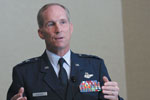 |
| Maj. Gen. Mike Hostage III, USAF, vice commander of Pacific Air Forces, calls for industry to focus more on solutions designed to help the military. |
For the U.S. Pacific Air Forces, industry needs to build solutions based on Air Force needs, not its own capabilities. Gen. Hostage told industry, “Show us what you’ve got, look at our problem set, then help draw the links between the two.”
The Pacific Air Forces are rolling out new technologies and capabilities to government and industry partners while seeking to consolidate for efficiencies. But, Gen. Hostage bemoans continuing cultural and technological hurdles to effective network centricity.
Among the new capabilities are voice over secure Internet protocol (VoSIP), which is in four bases and will be installed in all nine bases over the next 12 months. Airmen also are receiving secure mobile personal digital assistants with Defense Information Systems Agency (DISA) security for sending secure e-mail. And, network operations and CERT functions are consolidated into single Air Force network operations.
But Gen. Hostage wants effective systems delivered on time. “A perfect course of action late to the fight isn’t as good as a 90-percent solution delivered on time,” he said. And, these systems should serve military needs, not those of industry.
The Army can provide ballistic missile defense capabilities to the Pacific Air Forces’ air operations center. This helps improved missile threat defense. But, this data must be displayed on a separate monitor. Gen. Hostage wants that data to be consolidated with Air Force data so it can appear on a common monitor.
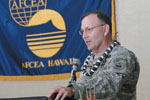 |
| Lt. Gen. Benjamin R. Mixon, USA, commander, U.S. Army, Pacific, relates that many countries that want to work with U.S. forces in the region are hindered by interoperability challenges. |
“There is a thirst and hunger for working with the
Current CENTRIXS systems provide bilateral linkage, but they cannot connect a complete coalition. The Army needs the multilateral Objective CENTRIXS in place before a crisis emerges, he stated.
High on Gen. Mixon’s technology wish list are an always-on network that can expand seamlessly; cost-effective wireless; a smart network that can mitigate workstation or information assurance problems automatically; and cross-domain solutions with multilevel security.
Gen. Mixon joined the other commanders in describing network security as a key force vulnerability. And, he acknowledged the need for nontechnological expertise in the force.
“We must be technologically advanced and culturally astute to be combat ready,” he declared.
Photography by Bob Goodwin
Pacific Intelligence May Rely on Commercial Assets A panel of J-2 officials cited the need for commercial technologies and capabilities to fulfill intelligence sharing needs across diverse coalitions and partnerships. And diversity was the name of the game in a pair of recent operations, both of which entailed disaster relief. After Burma/Myanmar was struck by a typhoon, the Panel moderator Thomas McNamara, the deputy J-2 with the U.S. Pacific Command, noted the irony in the The panelists agreed on the value of using commercial satellite imagery for information sharing. Other commercial capabilities that are playing an increasingly important role in that activity are open-source information and the Internet—particularly Google News, which was cited by Col. Joe Wheeler, USMC, G-2, U.S. Marine Forces Pacific. “You can’t put the genie back in the bottle,” Col. Wheeler said of the irresistible momentum that occurs once organizations start sharing information with nontraditional partners. Russ Horton, transformation official for U.S. Forces Korea, added that “It’s clearly policy that keeps us limited in information sharing.” |
Coast Guard Faces Embryonic Terrorism in the Pacific The U.S. Coast Guard’s fight against minor maritime law violations may be a precursor to terrorism activities, according to one of its district commanders. Rear Adm. Manson K. Brown, USCG, commander, 14th Coast Guard District, related how fishing violations in “I’m very concerned about the potential link between maritime crime and terrorism,” he stated. Solving the problem of illegal fishing in the 14th Coast Guard District—which spans vast areas of the Pacific near many small island nations—may also position the Coast Guard to deal with emerging terrorist threats in the region. Tight federal budgets preclude the possibility of the Coast Guard adding large numbers of ships and crews, the admiral said. Instead, the Coast Guard must rely on technologies to fill the gap. And, just as with conventional military operations, international collaboration is another key to success. Fish poachers can flee into waters of another sovereign island nation and grab fish there, which effectively defeats “We must be hyper-collaborative to solve problems,” the admiral declared. |
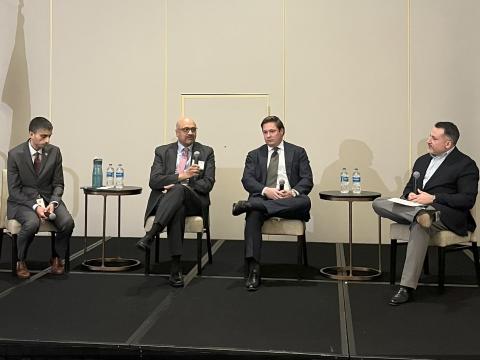
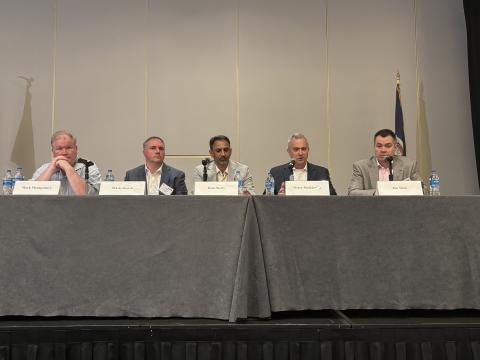
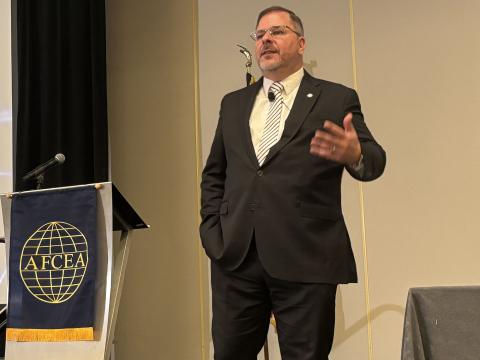
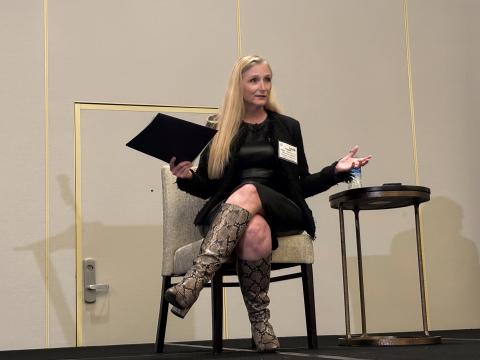
Comments